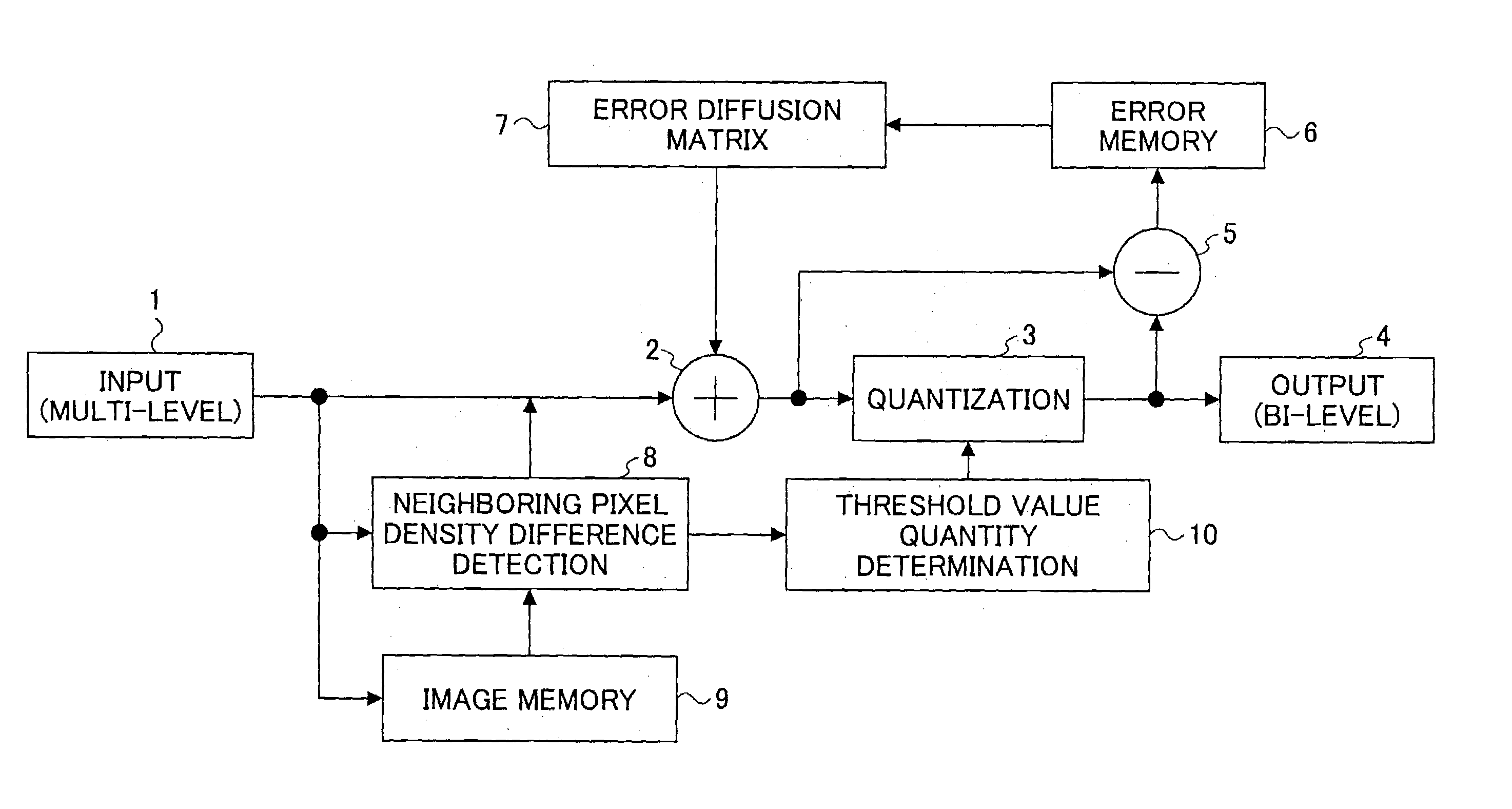Imaging apparatus and imaging method
a technology of imaging apparatus and image, applied in the field of imaging apparatus, can solve the problems of degrading the graininess of the image, increasing the whitened portion, and affecting the image quality,
- Summary
- Abstract
- Description
- Claims
- Application Information
AI Technical Summary
Benefits of technology
Problems solved by technology
Method used
Image
Examples
embodiment 1
[0126](Embodiment 1)
[0127]FIG. 21 is a diagram illustrating the configuration of a bi-level error diffusion process according to a first embodiment of the present invention. In this drawing, the input (multi-level) 1, the adder 2, the quantization part (bi-level) 3, the output 4 (bi-level), the subtractor 5, the error memory 6, and the error diffusion matrix 7 are the same as those of the conventional art shown in FIG. 1. In the present invention, a neighboring pixel density difference detection part 8, an image memory 9, and a threshold value quantity determination part 10 are added to the configuration.
[0128]In the following, the operation of the error diffusion process according to the first embodiment, wherein the threshold values shown in FIG. 6 are used and the threshold value corresponding to the adjacent pixels of FIG. 18 is implemented, is described. FIG. 22 is a process flowchart of the first embodiment of the present invention. First, image data for two lines are stored i...
embodiment 2
[0134](Embodiment 2)
[0135]In the above-described first embodiment, the threshold value varying in accordance with the input value (density) as shown in FIG. 6 is used and the sharpness can be controlled by determining the threshold value corresponding to the density of a neighboring pixel. However, the emphasizing effect depends on the inclination of the threshold value of FIG. 6.
[0136]Depending on the image design, there are instances in which greater emphasis on sharpness is demanded in the image, and there are instances in which the emphasizing effect is not greatly demanded. Thus, in a case where greater emphasis is demanded, the threshold value can be lowered when the edge has a raised density and the threshold value can be raised when the edge has a lowered density. On the other hand, in a case where emphasis is not greatly demanded, the threshold value is set slightly higher when the edge has a raised density and the threshold value is set slightly lower when the edge has a l...
embodiment 3
[0143](Embodiment 3)
[0144]In an output apparatus that has different reproducibility of thin lines depending on the scanning direction (primary scanning or sub scanning) such as the electrophotographic imaging apparatus, the emphasizing effect controlling coefficient α for the primary scanning and that for the sub scanning are preferably varied. In such a case, the predetermined coefficient for controlling the emphasis level being denoted as α, individual coefficients are assigned to each of the primary scanning and the sub scanning and a different coefficient α is used for each of the different scanning directions.
[0145]FIG. 29 shows the configuration of the third embodiment of the present invention. The difference between the second and third embodiment is that in the third embodiment, a signal for selecting either a coefficient α1 or α2 is sent to the secondary threshold value quantity determination part 10b from the detection part 8. That is, the detection part 8 notifies the sec...
PUM
 Login to View More
Login to View More Abstract
Description
Claims
Application Information
 Login to View More
Login to View More - R&D
- Intellectual Property
- Life Sciences
- Materials
- Tech Scout
- Unparalleled Data Quality
- Higher Quality Content
- 60% Fewer Hallucinations
Browse by: Latest US Patents, China's latest patents, Technical Efficacy Thesaurus, Application Domain, Technology Topic, Popular Technical Reports.
© 2025 PatSnap. All rights reserved.Legal|Privacy policy|Modern Slavery Act Transparency Statement|Sitemap|About US| Contact US: help@patsnap.com



